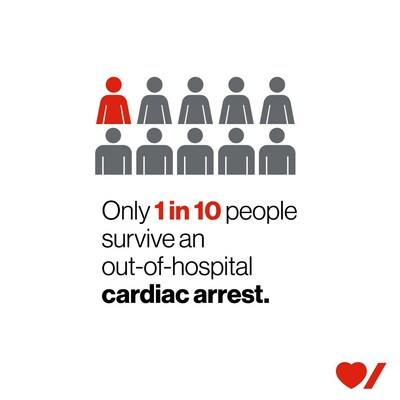Heart & Stroke report highlights the fast action needed to save more lives
TORONTO, Feb. 1, 2024 /CNW/ – According to a new report from Heart & Stroke, the number of cardiac arrests in Canada is significantly larger than previously estimated. The report Every second counts: Transforming resuscitation to restart more hearts reveals that approximately 60,000 out-of-hospital cardiac arrests are happening in Canada each year – that is one every nine minutes*. Unfortunately, only one in 10 people who experience a cardiac arrest out of hospital survive. The new data also indicates that nearly half of cardiac arrests happen to people under the age of 65.
Cardiac arrest means the heart has stopped beating. Out-of-hospital cardiac arrests are sudden, often unexpected medical emergencies that can happen to anyone, anywhere, at any age. Fast action saves lives: Immediate CPR keeps the blood pumping to keep the brain and other vital organs alive and an AED will shock the heart to help it restart. Survival drops significantly every minute without these life-saving measures.
Some progress has been made over the past several decades to address this time-sensitive but treatable condition, including improvements to CPR by both first responders and the public, and more availability of AEDs in some public places.
Quebec actor, singer and director Robert Marien was playing hockey at a local arena, when he suddenly collapsed on the ice. He was fortunate that his teammates and others at the arena recognized what was happening and knew what to do: they called 9-1-1 immediately, started CPR and got an AED. "I was so lucky! Everything was in place to save my life. I am extremely grateful for that chain of survival," says Robert. He now advocates for increasing public access to defibrillation. "It is simple," he says. "AEDs should be as common as fire extinguishers."
CPR rates vary across the country from between 42% to 72%, and the bystander AED rate is low at 13% in public places. AED availability in public places varies and they can be inaccessible, not properly maintained, and not registered in an emergency medical services (EMS) database and there are few AEDs in private locations where most cardiac arrests happen. Additionally cardiac arrest data is inadequate and inconsistent.
Inequities persist as rural, remote, and isolated Indigenous communities have greater difficulties accessing emergency and other medical services for cardiac arrest response and treatment. Women are less likely to be resuscitated by lay responders than men in public places. Support is lacking for everyone affected by cardiac arrest, including those who survive, family and friends, lay responders and EMS.
"We know that there are ways to save many more lives and every life is more than just that single life — every life is so important to their families, to their kids and their loved ones," says Dr. Jim Christenson, an emergency physician at St. Paul’s Hospital and co-director of BC RESURECT.
While there has been some progress over the decades, it isn’t nearly enough. To save more lives and improve outcomes we need to:
- Empower generations of lifesavers by ensuring more people recognize cardiac arrest, know CPR and take action.
- Place more AEDs in public places and ensure they are accessible, maintained, registered and linked with EMS, and extend access to AEDs in private locations.
- Ensure comprehensive, coordinated and effective emergency response systems.
- Drive transformative change through research, innovation and better data.
- Support everyone affected by cardiac arrest.
In 2012, Kim Ruether’s 16-year-old son, Brock, collapsed from cardiac arrest during volleyball practice at his school in Fairview, Alta. An AED was brought out, but no one was instructed to use it and Brock died. This tragedy inspired Kim to become a passionate advocate; she founded the Project Brock Society, with the goal of ensuring every school in Alberta is equipped with an AED and people are trained and prepared to take action. "If we train kids to do CPR and use AEDs, then we would have a whole citizenry trained. Kids have fire drills and lockdown drills; we need to do the same for emergency medical situations like cardiac arrest."
Heart & Stroke is committed to doubling the cardiac arrest survival rate, increasing bystander CPR and AED use, and improving outcomes for those impacted by cardiac arrest including survivors, lay responders, and families.
"We know what needs to be done to save more lives," says Doug Roth, CEO, Heart & Stroke. "That is why we are passionately committed to continuing to work with partners to raise awareness, increase CPR and AED skills, advocate governments across the country for polices, funding and regulations, support life-saving research and innovation, and equip health professionals to provide outstanding care."
*Using 2021 data from the Canadian Resuscitation Outcomes Consortium (CanROC), a nationally representative analysis was carried out by Heart & Stroke and reviewed by leading Canadian resuscitation experts. In addition to different data sources and analyses involved in calculating the most recent cardiac arrest incidence, there are likely other reasons for this larger number, for example, the population is both growing and aging — and age is a risk factor for heart disease, and other factors could include increasing prevalence of health-related risk factors such as high blood pressure and diabetes, environmental risk factors such as air pollution, COVID-19 and the opioid crisis.
Life. We don’t want you to miss it. That’s why Heart & Stroke has been leading the fight to beat heart disease and stroke for more than 70 years. We must generate the next medical breakthroughs, so Canadians don’t miss out on precious moments. Together, with the generous support of our donors, partners, and volunteers, we are working to prevent disease, save lives and promote recovery through research, health promotion and public policy. Heartandstroke.ca @heartandstroke
SOURCE Heart and Stroke Foundation

Featured image: Megapixl © Marilyna




